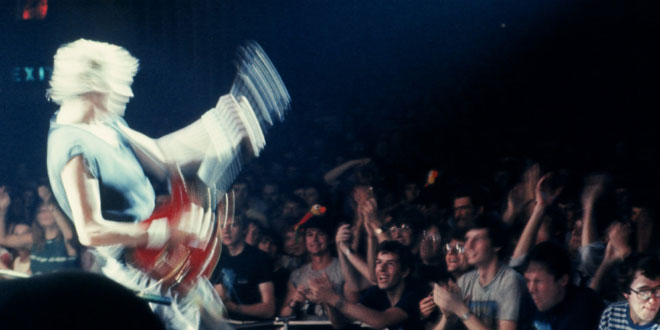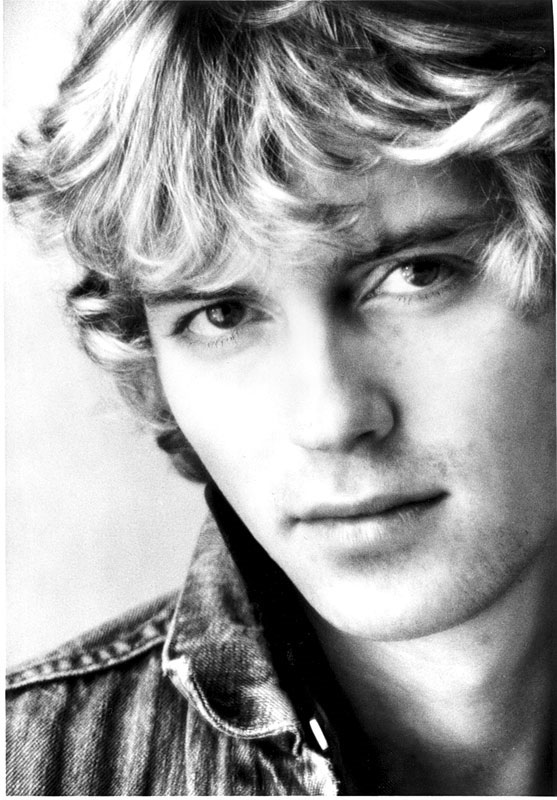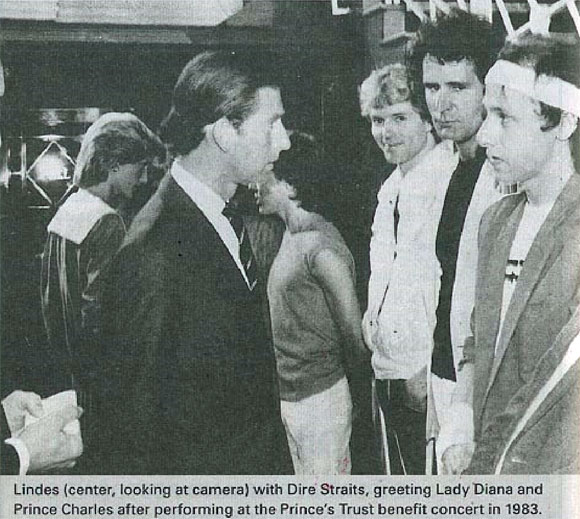“The Walk of Life before, during and after Dire Straits”

Hal Lindes: Well, I’d gone as far as I could in D.C. So I had to go to one of three cities – New York, Los Angeles or London. While I was still in high school, Mercury Records invited us to New York City to record demos, and I found it a bit rough and tough. Of course, I later grew to really love it. And coming from Monterey, I had a feeling I wouldn’t be us focused in L.A…. and would probably end up being a surfer (laughs)! As I was trying figure things out, Alvin Lee played in D.C. one evening and I ended up hanging out with him and his tech, who convinced me that London was the place to be. At the time, there was a host of weekly music papers there, one of which was the Melody Maker, which ran ads for musicians from semi-pro bands up to touring pro. So that was my plan, get to London grab a Melody Maker, join a great band!
Who was
in your first band there?
Hal Lindes:
There was Wilbur
Campbell and Alistair McKenzie,
but we kept changing members. We
were managed by Simon
Napier-Bell, the ex-Yardbirds
manager, and ended up being
singed by the Charisma Label,
which also had Genesis and Peter
Gabriel. Their studios were
above The Marquis club, where
just about everyone got their
start, on Wardour Street in the
heart of Soho. We did one album,
then kind of drifted apart. I
then did session work at George
Martin’s Air Studios. The band
was Brad Bradbury on drums,
Herbie Flowers on bass, Al
Kooper, and myself. Then, I got
a call saying, “Mark’s brother
has left (Dire Straits), would
you be interested in coming to
have a play?”
Timing
is everything…
Hal Lindes:
Timing is
everything. But I didn’t go to
the audition with any
preconceived notions, because I
was already working with Al
Kooper, which was pretty mind
blowing in itself. Anyway, they
were rehearsing in this place
called Wood Wharf, which was
this really funky rehearsal room
in south London, right on the
Thames, and there was a big
picture window overlooking the
river. We hung out for a while,
then started playing, and by
this time they were finishing
their third album, “Making
Movies”. I think first we
played “Tunnel of Love”, and it
was nothing short of amazing,
there was that magical,
mysterious combination of
certain guitars and certain amps
that just worked. After the
first chord, everybody pretty
much knew that was it. But yeah…
you get a phone call like that,
and you’re not going to say
“No”. One phone call, and your
life is all of a sudden going in
a completely new direction. I
was playing my ’59 Strat that
day and there was a particular
moment I’ll never forget, where
the sun was setting over the
Thames, and we could see guys
working on the barges. We played
“Sultans of Swing” as the sun
set on a particularly beautiful,
clear English summer day. I
later played that guitar on the
title track on Tina Turner’s
Private Dancer album, which
evoked a telephone call from
Fender, who were heavily
courting Dire Straits through
the back door – me – in attempt
to get an endorsement, saying
that the tone of that Strat
guitar in the intro was the most
definition split-pickup Strat
tone they’d ever heard. They
must have really wanted a DS
endorsement (laughs)!
How
long were you in Dire Straits?
Hal Lindes:
From 1980 to 1985.
What
was it like working – and
playing guitar with Mark
Knopfler?
Hal Lindes:
Mark really is a
hell of a player. I’ve never
really come across anyone like
him. In those days, he wasn’t
particularly into leaving music
up to chance; all of his long,
lyrical guitar solos were
scripted, almost like he was
performing a classical piece of
music with the notation inside
his head. He would play really
long solos, which were pretty
much the same night after night,
unlike most rock guitarist, who
use in and out points with
improvisation in between. The
danger of live, on the fly
improvisation, as all guitarist
know, is that some nights, the
solos might be amazing, but
other nights, they might be
absolute crap. With Mark, it was
consistently on the money, night
after night. In five years of
touring with the guy, I could
probably count the number of bum
notes on one hand. He was very
precise.
Any
particularly memorable gigs come
to mind?
Hal Lindes:
We once did two
weeks at Wembley Arena, next to
Wembley Stadium and Eric Clapton
came to every gig.
Was
this before Mark was in
Clapton’s band?
Hal Lindes:
Yes, I get the
feeling that Clapton, who I
imagine relies upon a degree of
on-the-night inspiration for his
brilliant soloing, was quite
curious about Mark’s more
scripted approach. I wondered
whether Eric was studying the
regularity of the guitar
performances between all the
shows, or simply digging the
music.
What
was your role in the band?
Hal Lindes:
My role was
second guitarist, backing up
Mark. He was generous to me, as
a player, and I’d get a few solo
spots. In rehearsals, he often
gave me first crack at working
up a part other time he already
had a second guitar part worked
out, or he would fashion a part
from where I was trying to go.
He wore a lot of hats. He’s
known for his playing, but is an
astonishing songwriter and a
great musical director.

That’s
different from most bands…
Hal Lindes:
There was
tremendous pride in the band. We
tried to be the very best we
could be. And the band was
really, really good. People who
saw us in concert, even if they
didn’t particularly care for the
music, would tell us afterward
how unexpectedly blown away they
were. The band was hungry and
dedicated. Having gotten to that
point, the après gig
scene was nothing like I
expected. Having friends in
other touring bands at the time,
hearing their road stories of
after-gig experiences…All I ever
got for an after-gig experience
was some fan in the hotel bar
asking what gauge of strings I
used. It was that kind of band,
it was being a musician in a
band that was appreciated for
the music, and not the haircut.
There wasn’t a glamour person up
front.
What
gauge of strings do you use?
Hal Lindes:
Well, back in the
day, Mark and I used Dean
Markley, .009s – on some guitars
I would use light top, heavy
bottoms, starting with .009s.
Now of course heavy strings are
king, so some of my guitars have
.010s, some .011s, and some
.012s. I spent most of my life
using .009s, but they now feel
really weird.
What do you remember most about meeting Prince Charles and Lady
Diana at the 1983 Prince’s Trust benefit concert?
Hal Lindes: It was pretty amazing. we were Princess Diana’s
favorite band at the time, and were invited to perform for the
Prince’s Trust. It was one of those rare balmy English summer days,
and we had been on tour for about 10 months, so it was probably the
performance peak of Dire Straits. Duran Duran was on the bill, so
the building was surrounded by screaming 13-year-old girls. Pete
Townsend seemed to be running the show, and I remember spending
considerable time in a hot dressing room, deafened by the hysterical
cries for Simon LeBon.

What do you most
fondly remember about working
with Tina Turner on Private
Dancer?
Hal Lindes:
Well, first we
should mention that when Mark
turned up for the Dire Straits –
Love Over Gold sessions, he had
a load of new songs, and it was
slated to be a double album. But
then, a group of songs started
to bond, and the album became a
single disc. Well, one of the
tunes that was not included was
the brilliant “Private Dancer”.
Tina was in London, working on
an album and her manager, Ed
Bicknell, if there were any Dire
Straits songs laying around.
When she heard “Private Dancer”,
she flipped. The band was
invited to record it, so we got
to the studio an hour or two
before Tina, and we cut the
track. She arrived, sang it
twice, was called into the booth
for playback, heard the first
take, and said “Fine”. The
producer asked if she wanted to
hear the second take, but she
said, “No”, and off she went.
She later invited Alan Clark and
me to join her for a couple
weeks on tour. Tina is an
extraordinary persona. She’s
quite elegant and sophisticated,
a Buddhist who seemed at peace
with the world. And it was such
a thrill to play with her.
What
was your amp setup at that time?
Hal Lindes:
It was a Musicman
2×12 through a Marshall 4×12
slant cab, a candy-panel early-
‘60s Vox AC30 top-boost, and
later a Simul-class Boggie.
Also, I used a Roland 550 Chours
Echo, a Morley volume pedal, and
an old MXR phase pedal.
Knopfler had something to do
with you getting into film
scores, right?
Hal Lindes:
He and I were
both interested in scoring
films. I was greatly impressed
with Ennio Morricone, who did
the early Eastwood
pop-influenced themes, like for
The Good, The Bad and The
Ugly. Mark included the
band in a project scoring a film
called Local Hero. I
hung out, watched, and I
learned, figuring that after I
hung up the Strat, it would be a
cool thing to get into. I hadn’t
made tons of money, but enough
to enable me to do what I wanted
to do, artistically. I wanted to
jockey myself into a position
where I follow my heart. And
doing film scores has kept me
involved in music, so I feel
very blessed. Working with mark
opened a lot of avenues for me,
and still does. It influenced my
arrangement capabilities and
sense of harmony. I learned a
lot from him, and he was very
generous with his musical
knowledge and talent. It gave me
a great base from which to move
into film scoring. And on every
new project, I have to reinvent
myself. Whatever the pictures
demand, I must do and I often go
into uncharted territory.
The
song “Brothers in Arms” has such
a David Gilmour – like feel to
the phrasings and style, it
could have been a Pink Floyd
tune.
Hal Lindes:
There wasn’t an
obvious influence that Mark
shared with us – that’s Mark’s
deal. Creative people have a
process, and Mark did a lot of
research before he recorded an
album. And he listened to a lot
of stuff. Around that time, Mark
was listening ZZ Top’s
Eliminator and Pink Floyd’s
The Wall, I believe.
It’s been so long I can’t
remember the details but there
were certain CDs around hat Mark
liked to listen to. As far
sounding like Gilmour, if
anything, it could only have
been a subconscious thing.
What
followed Dire Straits?
Hal Lindes:
You know I had
played in bands for so long I
never thought there’d be a time
where I wasn’t in a band. But
when the Dire Straits period was
over, I had to take a long, hard
look at myself and say, “What do
I do now?”. And I realized that
anything I did as a guitarist
would be anticlimactic. That was
a pretty tough realization to
come to terms with.
Describe your creative process.
Hal Lindes:
It’s different every time, but
any score is more evocative,
personal, and poignant when I’m
able to use the guitar. I watch
the scene a few times, then pick
up a guitar and start following
the scene like I would follow a
singer – picking up on the
emotional highs and lows, the
pace and tension – the guitar is
one of the few instruments that
manages to reach in and
instantly connect with the soul
in a non-divisive method, like,
say lush, syrupy strings do. The
palette is vast – you’ve got
electric, acoustic, six-string,
12-string, baritone, Nashville
tuning/random tuning. I try and
stay away from amp simulators –
“character killers,” as I call
them – because nothing lives,
breathes, and sings like an old
tube amp. You can achieve so
much more with a few notes from
a guitar than a lot of notes
from a group of orchestral
instruments.
Your
name is on the credits for the
song “Brothers in Arms” on some
albums, and on others albums,
it’s not…
Hal Lindes:
Yeah, that was a weird period. I
started with the band in the
early rehearsal, and the album
sessions lasted about a year,
then the album was re-cut a few
times. After that, I left the
group.
With
studios in London and Los
Angeles, it must be hard to have
everything you need at each
location.
Hal Lindes:
The trick is to
carry as much stuff as possible
on computer drives. That way,
your studio is always with you –
the libraries, reference scores,
etc. I have most of the Dire
Straits guitars in storage in
London, and use them on European
soundtracks scores – the fun
stuff is in the L.A. studio,
where I’m able to use many
different instruments. For
garage raunch it’s a ‘60s
Gretsch Jet Firebird with
Supertrons and active
electronics through a ’59 Fender
Champ. And in the corner of the
studio is the Tama drum kit
Stuart Copeland used to record
the first Police album. For
scoring, I often use the
10-string Charango and a
baritone Kamaka eight-string
ukulele. I also often use a
Danelectro baritone and a ’59
National solidbody electric. I
recently did a film score using
a ’72 Fender Telecaster Deluxe
through a ’64 Vibro-Champ. I was
floored by how great the Tele
sounded – I always considered
’70 Fenders to be fairly awful.
The guitar had been in storage
since Mark banned it from the
Brothers in Arms
rehearsals for being too ugly!
What
are you currently working on?
Hal Lindes:
I just completed a quirky score
for the BBC’s modern adaption of
Taming of the Shrew,
and one of my favorites is a
12-string acoustic score for a
six-hour series called
“Reckless”. We started with an
orchestral score, but that
killed the film in its tracks.
But it was amazing how the
12-string guitar just brought
the film to life.